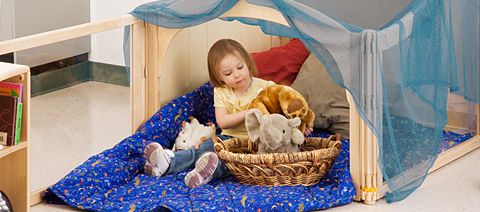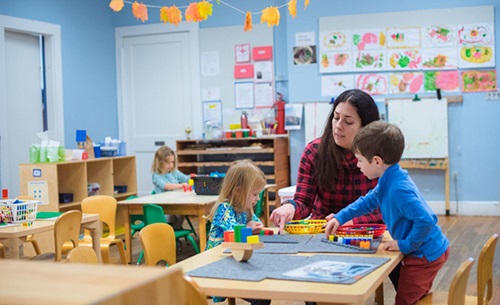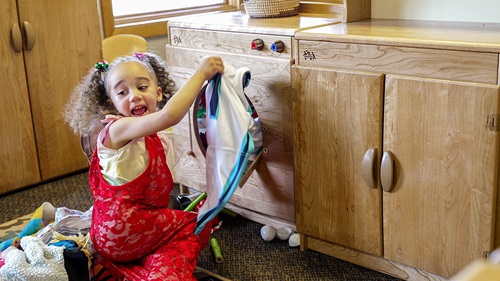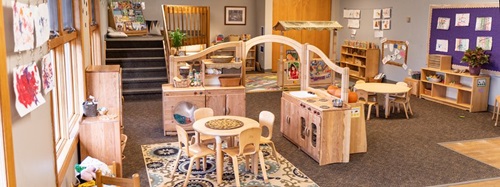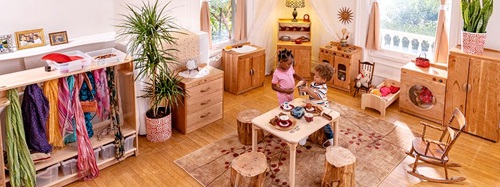How Soft is Your Early Childhood Environment?
| September 2008Anytime I encounter children who have been in a child care center, I ask them what they remember about it. Invariably their memories are about the agony of lying still at naptime, playing in the sandpile, having to eat beans, having one’s back rubbed at naptime, or being outside on hot days. Apparently, their memories are stored primarily as tactile-sensory impressions. (Prescott 1979, p. 1)
Observing in child care centers, preschools, and family child care homes, we discovered several key dimensions of the environment that clearly make a difference in the quality of the experience for both children and the adults who care for them. One of these dimensions is softness/hardness. All of them can be analyzed and changed by thoughtful educators and caregivers.
Making the Center Softer
When we started thinking about softness as a dimension of programs for children, we looked at a lot of things that seemed to make a difference to children’s experience in the environment. These were the indicators we decided to use in measuring the softness of a day care center, both indoors and outdoors:
- Child/adult cozy furniture: rockers, couches, stuffed chairs
- Large carpet or rug
- Grass to be on
- Sand to be in: box or area
- Dirt to dig in
- Furry animals to hold
- Sling swings
- Play dough
- Very messy materials: finger paint, clay, mud, water added to sand
- Water as an activity
- “Laps” (available for children to sit on)
The basic quality common to all the softness indicators is sensory responsiveness. When you touch water, or a swing, or a pillow, it responds to your touch; it moves. It doesn’t just resist you like a hard floor or chair. You can use your body the way you want to on a rug. You push sand around or pound on clay, and each does what you want it to do.
Introducing greater softness into a child care environment makes it more interesting, more educational, and more comfortable; it may also be a way of reducing tension in both children and adults. Sensory responsiveness is a crucial quality in any leisure environment – and if full day care cannot be characterized as a leisure environment, its inhabitants, big and little, will almost invariably experience frequent tension and fatigue. These lead to undesirable behaviors, as both children and adults “come unglued” at the end of the morning or the end of the day.
I’ve seen some interesting solutions to this problem. Usually the solutions provide for increasing softness. For example, having children take their shoes off before lunchtime is a way of letting them wind down and of letting them know there is a different part of the day coming. I also remember a center where children were really at loose ends after the usual end of the morning cleaning-up and washing-up. Each adult then took her children into a quiet enclosed area that had a rug and pillows. They had a nice intimate time together – talking or reading stories. The children lounged on the pillows and were relaxed and calm for lunch and naptime.
One thing that really surprised me in our observations was that it was the adults more than the children who had a difficult time coping with the final hours of the day. After the children got up from their naps, they were raring to go again. It was the adults who appeared fatigued and less effective.
Child care programs will go to a great deal of trouble and expense to provide activities and equipment they think are good for children. But it wouldn’t occur to them to get a really comfortable easy chair for an adult who has been there for eight hours.
Likewise, I know of centers where adults may not sit down when children are outside. But a yard ought to be safe enough so that an adult can sit down. Just as with the easy chair inside, once the adult sits down, she really becomes accessible to children. She can snuggle and converse in a close way which is impossible when she is standing up.
If you want an adult to nurture children, she’s got to feel that she’s nurtured too. (Prescott, 1979, pp. 4-5)
Child Care Centers: Home or School?
A home is a behavior setting whose purpose for existence is the meeting of day-to-day human needs. Suppose that all day care had as its goal the provision of the experiences found in homes? In a center which looked more like a home there would be easy chairs to provide quiet corners for privacy; there would be a couch and adult-sized chairs where staff could sit comfortably and rest occasionally, instead of perching on tiny nursery school chairs. Children would be involved in the daily operation of the center, like putting sheets in the washing and helping with the cooking.
It is very easy to convince people that they themselves love the comforts of softness that we have advocated for children. In fact, it is difficult to discuss this topic without interruptions from adults who want to tell us of their particular pleasures, such as the relief of coming home, taking off their shoes and flopping on the couch. Why then do we see so much hardness in centers?
Administrators exist to solve problems, and one simple way to solve problems is to forbid anything that causes them. Some insurers do not like swings or cozy tree houses. Janitors argue that carpets, couches and pillows are hard to keep clean and look messy compared to vinyl floors and hard chairs. Sand has a way of appearing in places where it doesn’t belong, and water play often results in wet and muddy children.
Administratively, it is often easier to eliminate these circumstances than to defend and support the reasons for their existence. As long as we conceive of day care as an early form of school, then the creation of a hard environment can be used as a rationale for eliminating all these potentially messy features that are loved by children. Efficiency cannot substitute for quality in early childhood settings. The provision of areas of softness is a lifelong need.
Summing It Up
The soft/hard dimension indicates the extent to which an environment is responsive to its inhabitants, especially on a sensuous/tactile level. A good play environment, in which children choose their activities, must, in our experience, include a large share of softness in order to work well.
The younger the children, the more essential softness becomes in an environment. Infants need response rather than recalcitrance in the materials they encounter (there is plenty of recalcitrance in their world already, from hard floors on up) – things that move and flow in response to their experimentation.
As people grow older they can deal with more hardness. Most of our work and public environments, including schools, overestimate this capacity, however. “Civilizing” work as well as play environments can pay off, nowhere more than in educational settings. A civilized environment includes softness.
(Adapted from Elizabeth Jones & Elizabeth Prescott, Dimensions of Teaching-Learning Environments, Pacific Oaks College, 1984, pp. 15-17)

